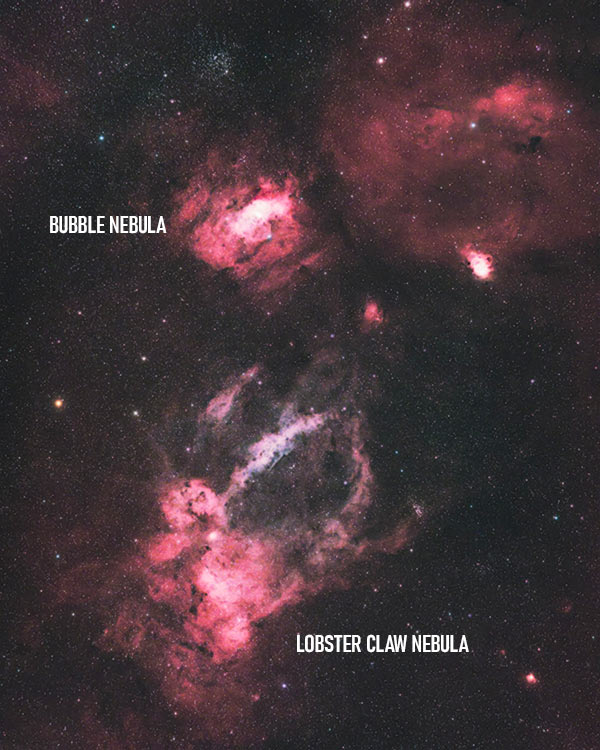NGC 7635 – The Bubble Nebula
The Bubble Nebula (NGC 7635) is an HII region in the constellation Cassiopeia. Its iconic “bubble” shape was created from the stellar wind created by the intensely hot central star (SAO 20575).
Also designated Sharpless 162 and Caldwell 11, this unmistakable emission nebula sits within a giant, glowing molecular cloud. The Bubble itself is about 10 light-years in diameter.
Through an 8-inch Dobsonian telescope with enough aperture under dark skies, the Bubble Nebula appears as an extremely faint shell around the central star.
To view the Bubble Nebula visually, you will need dark skies (Bortle 3 or better). I can’t observe this faint emission nebula from my city backyard.
Like many of the deep-sky objects you see on this website, I have only seen them appear in images with my camera and never with my eye through the telescope eyepiece.
The Bubble Nebula in Cassiopeia.
The image above was captured in my backyard using a refractor telescope and a monochrome CCD camera. To learn more about astrophotography and how you can start taking photos of the night sky, visit the Get Started section of this website.
Bubble Nebula Details
- Common Name: The Bubble Nebula
- Type: Emission Nebula
- Cataloged: NGC 7635, Sharpless 162, Caldwell 11
- Constellation: Cassiopeia
- Distance: 7,100 light-years
- Magnitude: 10
- Apparent dimensions (V): 15′ × 8′
The Bubble Nebula is close to an impressive open star cluster, Messier 52. You can photograph this star cluster within the same field of view as the Bubble Nebula using a wide-field telescope or telephoto lens.
This area of Cassiopeia is populated with several interesting nebulae regions, including the Lobster Claw Nebula. With the right magnification, you can capture the Bubble Nebula and Lobster Claw Nebula within a single frame.
The Lobster Claw Nebula and Bubble Nebula in Cassiopeia.
When is the Best Time to See the Bubble Nebula?
Cassiopeia is a circumpolar constellation in much of the northern hemisphere, meaning it can be visible all year round in higher latitudes.
However, the best time to observe the Bubble Nebula is during the fall and early winter months, specifically from September to December, when Cassiopeia is highest in the sky and well placed for observations and astrophotography.
This increased altitude reduces atmospheric interference, providing clearer and more stable viewing of the Bubble Nebula.
For the best experience, observing from dark, rural areas far from city lights is recommended, using a telescope with sufficient aperture to resolve the delicate structure of the nebula.
I typically begin shooting this emission nebula in August and continue to collect new exposures throughout September and October. I have photographed the Bubble Nebula many times, using several different camera and telescope configurations.
The Constellation Cassiopeia. (The Bubble Nebula is marker #1)
Astrophotography
Through long-exposure photography, amateur astrophotographers can collect the light emitted by this nebula over long periods. My best image of the Bubble Nebula includes roughly 6-hours of total exposure time.
Narrowband filters are recommended when photographing the Bubble Nebula. Unlike broadband deep-sky targets such as galaxies or reflection nebulae, NGC 7635 does not reveal its best self in traditional RGB imaging.
Emission nebulae are especially pleasing to the eye with the help of an H-alpha filter. The image below shows what the Bubble Nebula looks like when photographed through H-alpha and OIII filters from a city backyard.
The Bubble Nebula in HOO (with RGB Stars). ZWO ASI2600MM Pro + Sky-Watcher Esprit 100.
The 6nm bandpass of the hydrogen-alpha filter allows a very narrow wavelength of light to pass through to the camera sensor in the 656nm range. This is helpful when isolating the light emitted from the Bubble Nebula from a light-polluted sky.
A monochrome CCD camera is an ideal choice for narrowband imaging, as it allows much more signal to reach the camera sensor than a traditional daytime (color) camera. I typically use a Starlight Xpress 694 Monochrome CCD camera to take my narrowband images, but there is value in shooting narrowband filters for one-shot-color astronomy cameras.
There are several types of telescopes to choose from, but I prefer to use an apochromatic refractor for astrophotography (here are some of the ones I recommend). For my latest image of the Bubble Nebula, I used a large Sky-Watcher Esprit 150 refractor telescope with a focal length of 1050mm. You can see a picture of my imaging setup below.
The astrophotography setup used for my latest photo of the Bubble Nebula. (Sky-Watcher Esprit 100 + Wave 150i mount)
More Nebulae in Cassiopeia:





